July 27, 2013
by Carole Zangari -
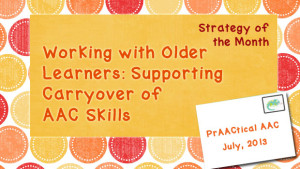
One of the biggest challenges that SLPs face is how to help the communicator use new skills outside the therapy room. Whether the client is someone who stutters, has voice problems, or any other speech-language difficulty, the question is the same: How can we get the client to use skills that were learned and practiced in a therapeutic situation to use those same skills at home, in school, and in the community? It’s an issue with all learners, but for adolescents and adults, we seem to be playing ‘catch up’ all the time. Plus, they are encountering greater numbers of less familiar communication partners and have to fend for themselves more often, making skill generalization even more of a critical topic. Much has been written about problems of generalization by using loose training, and varying the instructional setting, partners, instructions, prompts, and materials. In our way of thinking, it starts... [Read More...]
Filed under: Strategy of the Month
Tagged With: generalization
July 20, 2013
by Robin Parker -
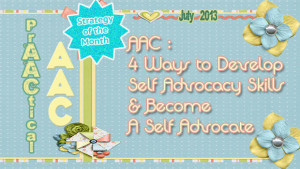
Self Advocacy comes in many shapes and forms for all learners. We all need to have a level of self advocacy skills to have a positive self-esteem, to continue a path of life long learning, and to defend and protect ourselves in situations that potentially can be harmful. The teaching of self advocacy begins with learning to request and protest but goes way beyond that for ALL learners. For those with AAC needs, specific strategies and direct instruction are often necessary to make self advocacy a comprehensive and robust skill. Self advocacy skills are a priority for older learners so for our Strategy of the Month, we will discuss some ways to help develop self advocacy skills beyond the requesting and protesting levels. We hope to build strong self advocacy skills for ALL learners. Rating Scales– Teach the use of rating scales to help AAC learners give their opinions on... [Read More...]
Filed under: Strategy of the Month
Tagged With: self-advocacy
July 13, 2013
by Robin Parker -
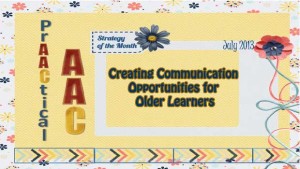
The Strategy of the Month involves AAC and the ‘older learner’. The ‘older learner’ involves a range of ages (We are ‘older learners’ for way longer than we are children) as well as a wide range of functioning levels. Even with this variation though, we know that ALL older learners can learn. There are challenges with ‘older learners’ that need to be addressed in order to facilitate spontaneous and generative communication and language. The challenges may result from years and years of going to intervention (some of it effective, some not), from perceived failure by the learner and/or the professionals, or may even just be related to that ‘teenager or adult’ independent streak. These challenges can definitely be overcome in order to help develop a functional and robust communication system for ALL learners. Just remember respect the learner as a competent teenager or adult (e.g., think what a typical language... [Read More...]
Filed under: Strategy of the Month
July 6, 2013
by Carole Zangari -
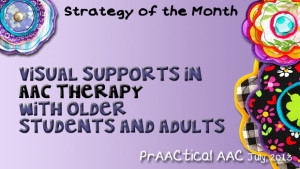
When learners are still struggling with communication in their teenage years and beyond, it means we have a lot of catching up to do. There are lots of implications for us as SLPs, of course, but the main one is this: Every interaction should have a purpose. As we head to the waiting room or classroom to see this student, we’re focused on how we can elicit practice on meaningful skills in the next few minutes. On a good day, we can use these few minutes before the session productively. Before we get to the therapy room we try to: use expectant pauses and graduated prompting to elicit a greeting at his/her highest level engage him/her in conversation to practice social exchanges provide opportunities for him/her to respond to a non-obligatory communicative context and facilitate a response make basic requests, like asking for help to open the door that we’ve... [Read More...]
Filed under: Strategy of the Month
Tagged With: adolescent, adult, anchor chart, download, resources, teen, visual supports
June 29, 2013
by Carole Zangari -
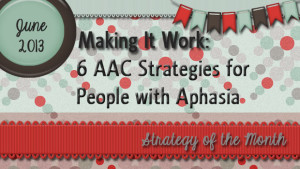
People with aphasia are often most successful when a number of different strategies are combined. In this post, we discuss a number of strategies that we can use in our therapy and teach to communication partners. Augmented Input We’ve written so many posts about aided language input that we’re almost embarrassed to bring it up again. Almost. It seems like no matter which age group or clinical population is the subject of our post, that strategy plays a central role. It is the same for people with aphasia with one exception. They benefit from a broader array of input cues, such as gestures, writing, and even pantomime. Augmented input is the term that is used to refer to oral language that is supplemented with pictures, print, gestures, pantomime, and the use of objects in the environment. By using these things as you speak, you enhance the ability of the person... [Read More...]
Filed under: Strategy of the Month
Tagged With: aided language input, aphasia, augmented input, communication book, rating scale, supplementation, tagged questions, written choice strategy
June 22, 2013
by Robin Parker -
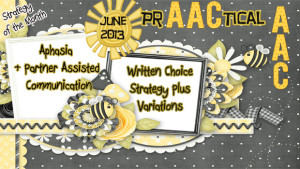
This month, we have enjoyed writing about communication strategies for aphasia. Partner supported communication is the platform for many of the effective techniques we use to help people with aphasia initiate, maintain, or terminate communication and conversation. We have talked about assessment strategies, communication books, and alphabet & topic supplementation. Now it is time to discuss the written choice strategy. The written choice strategy is fairly easy to implement, can look natural, and can result in seamless detailed conversation. Written choices are provided in the context of conversation and are displayed in an organized manner. What is It? The written choice strategy has the partner/facilitator generating written key-word choices that relate to the conversational topic. The written choices can be paired with text, pictures, drawings, symbols, and natural speech. The partner/facilitator writes possible answers to conversational questions in list form. The conversation is extended as continued written choices are offered... [Read More...]
Filed under: Strategy of the Month
Tagged With: aphasia, rating scales, Supported Communication, written choice strategy
June 15, 2013
by Carole Zangari -
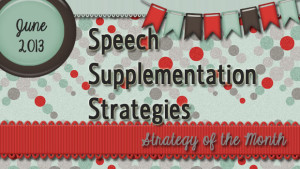
Anyone who has had a conversation with someone affected by aphasia is probably familiar with the ‘20 Questions’ approach to resolving communication breakdowns. Asking questions helps us take the piece of the message we understand (or think we do!) and build on that to gain more insight into the communicator’s intent. Take this exchange between a woman, Sandy, and her mother-in-law, Joan. Joan had a stroke a few years back and has both aphasia and dysarthria. Joan: “Gay” Sandy: “Gay? What do you mean, mom? Someone’s gay?” Joan: Shake head. “Gay” Sandy: “I’m not sure, mom. Gay?” Joan: “Gay” Points to the front door Sandy: “Kay? Are you telling me about Kay from across the street?” Joan: “Gay.” Nods Sandy: “What about Kay? Did she call?” Joan: Shakes head no Sandy: “Do I need to call her?” Joan: Shakes head no Sandy: “Did she stop by?” Joan: “Aaadihdih” Sandy: “Did... [Read More...]
Filed under: Strategy of the Month
Tagged With: alphabet supplementation, aphasia, speech intelligibility, supplementation strategies, topic supplementation
June 8, 2013
by Robin Parker -
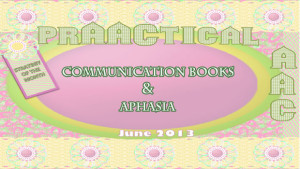
We know aphasia intervention has moved well beyond traditional speech and language training and intervention. We are so happy it has moved to an authentic participation, functional communication, and social interaction focus. Communication books are one tool for helping people with aphasia be active participants in conversation and comprehensive communication. Here are some thoughts and ideas about communication books to get started. Communication Books- Communication books for adults with aphasia can be in grid format with relevant communication messages. There can be a few pages or many, but keep in mind that the more pages, the longer it will take to navigate. It is most important to include high priority and relevant messages that will support needed communication and not just ‘standard’ messages. There are many samples and templates that can be purchased or downloaded for adult communication books. These may be good as a start, but should be individualized when... [Read More...]
Filed under: Strategy of the Month
Tagged With: AA, aphasia, COmmunication Books
June 1, 2013
by Carole Zangari -
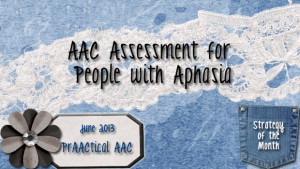
Many people with aphasia fail to regain sufficient speech and language skills to meet their communication needs. With more than one million people with aphasia in the US alone, chances are most people reading this know at least one person affected by the disorder. While many go on to regain functional speech and language skills, some remain unable to communicate well enough catch up with a neighbor, talk about bills with a spouse, ask a question in a store, play with a grandchild, or tell their healthcare providers about side effects or symptoms. It’s hard to really imagine how devastating and isolating this experience may be. Aphasia Awareness Month seemed like the perfect time to reach out to SLPs with information on AAC for people with aphasia. In this post, we’ll share some thoughts and resources on assessment. Assessment activities are, of course, driven by the purpose for which the... [Read More...]
Filed under: Strategy of the Month
Tagged With: aphasia, assessment, Joanne Lasker, Kathryn Garrett, MCST-A
May 25, 2013
by Robin Parker -
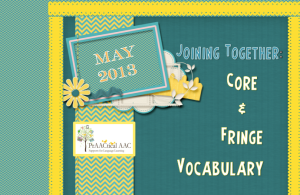
Last month we talked about Core Words, and we shared core word samples, philosophies, and resources. As we have moved into May’s Strategy of the Month, Communication Boards, we now want to share ideas about joining core and fringe words together on communication boards. Core vocabulary are those words used with high frequency and make up about 75-80% of the words we use everyday. Core vocabulary should be a main part of all AAC systems because it allows for most flexibility across most situations. With an emphasis on core words, we also use Fringe Vocabulary 20-25% of the time. Fringe vocabulary are used in a continuum of low-frequency to lower frequency situations (e.g., ‘mountain’: ‘glacier’, ‘crevasse’). Personal vocabulary can also be included under fringe vocabulary and would relate to personal words someone might need for their individual needs, interests, work, school, or even community. So, in the best communication world, AAC users would have access... [Read More...]
Filed under: Strategy of the Month
Tagged With: communication boards, core vocabulary, fringe vocabulary









